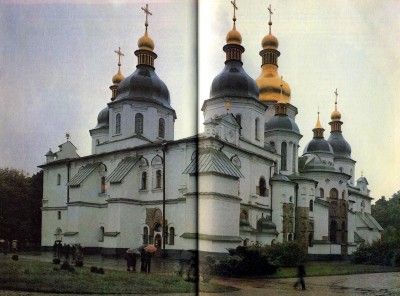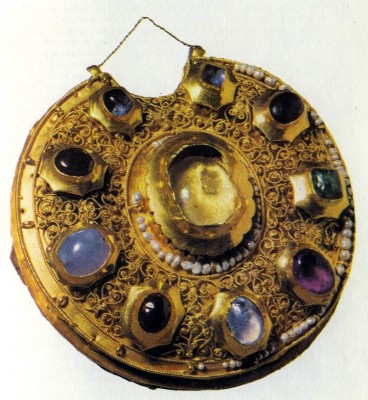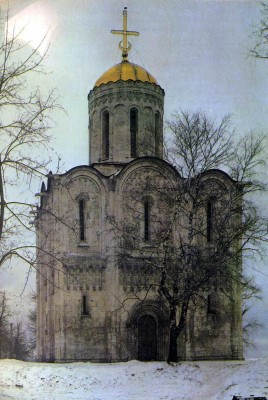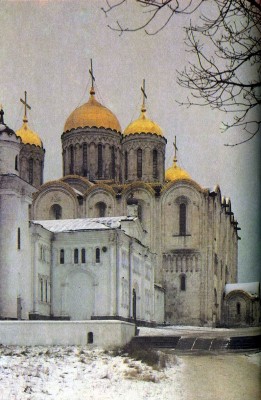The Tale of Bygone Years
At the beginning of the 12th century (around 1113 it is assumed) The Primary Chronicle was again revised, this time by the monk Nestor of the Kiev Crypt Monastery. Nestor’s work became known among specialists as The Tale of Bygone Years from the opening words of its lengthy title: “Se povesti vremyanykh let…” (that is, “This tale of bygone years, of the origins of the Russian land, the first to rule in Kiev and how the Russian land came to be.”).46
Nestor was a scribe of great historical vision and literary skill: before his work on The Tale of Bygone Years, he wrote a Life of SS Boris and Gleb and a Life of St Theodosius of the Caves, Nestor set himself the impressive task of not only adding to The Primary Chronicle a description of the events of the late eleventh and early twelfth centuries, which were within his lifetime, but also of radically revising the account of the early period of Russian history.
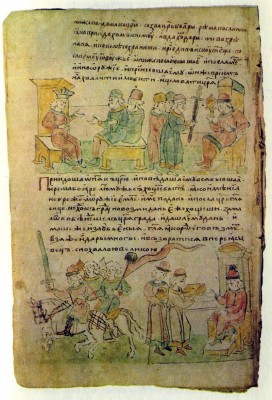
The Tale of Bygone Years. The Byzantine Emperor with His Courtiers. Byzantine Envoys Bring a Sword to Prince Svyatoslav of Kiev. Illumination from The Radziwill Chronicle. 15th century. Academy of Sciences Library, Leningrad
Nestor brings the history of Russia into the mainstream of world history. He begins his chronicle with an account of the Bible story about the division of the earth between the sons of Noah. Quoting a long list of the peoples of the world (which he borrowed from the Chronicle of Georgios Hamartolos), Nestor inserts a reference to the Slavs; in another passage the Slavs are identified with the “Noricans”, the inhabitants of a province of the Roman Empire on the banks of the Danube. Nestor gives a detailed account of the Ancient Slavs and the territory occupied by the different Slavonic tribes, with special detail about the tribes that inhabited the territory of Rus (Old Russia), in particular,about the “gentle and mild disposition” of the Polyane, on whose lands the town of Kiev was built. Nestor amplifies and develops Nikon’s Varangian story: the Varangian princes Hoskuld and Dyri mentioned in The Primary Chronicle are now declared to be boyars of Rurik’s (and not even “of his tribe”) and the campaign against Byzantium in the reign of Emperor Michael is ascribed to them. Having established from official documents (the texts of treaties with the Greeks) that Oleg was not Igor’s voevoda but was a prince in his own right, Nestor proffers a version according to which Oleg was a relative of Rurik’s and acted as regent during Igor’s minority.47
At the same time Nestor includes some new (by comparison with The Primary Chronicle) historical folk legends, such as the story of Olga’s fourth revenge on the Drevlyane and the tales of the combat of the young tanner with the giant Pecheneg and the siege of Belgorod by the Pechenegs.
So it is to Nestor that The Tale of Bygone Years owes its historical breadth of vision, the insertion of information about world history against the background of which the history of the Slavs, and subsequently of Old Russia, is developed. It is Nestor who elaborates and polishes the story about descent of the Russian princely dynasty from a “summoned” Norman prince. Nestor actively supported the ideal state organisation of Russia proclaimed by Yaroslav the Wise, namely, that all the princes were brothers and that they should all submit to the most senior brother who held the throne of the Grand Prince of Kiev.
Thanks to Nestor’s statesmanlike views, breadth of vision and literary talent The Tale of Bygone Years was “not merely a collection of facts about Russian history, nor an historico- publicistic work concerning the pressing, though transient tasks of Russian life, but a complete history of Russia expounded in literary form”.48
It is assumed that the first redaction of The Tale of Bygone Years is not extant. What has survived is the second redaction compiled in 1117 by Abbot Sylvester of the Vydubitsky Monastery outside Kiev and the third redaction compiled in 1118 on the orders of Prince Mstislav Vladimirovich. In the second redaction only the final section of the Tale was revised; it is this redaction that has survived in The Laurentian Chronicle of 1377 and other later chronicles. The third redaction is to be found in The Hypatian Chronicle, the oldest copy of which, the Hypatian MS, dates back to the first quarter of the fifteenth century.
This redaction contains some interesting references to sources on world history. Under the year 1110 the chronicler quotes an extract from the Josippon, a mediaeval chronicle of Jewish history (which is known to have been translated from Hebrew to Russian),49 the story of how an angel forbade Alexander the Great to wage war on Jerusalem. Under the year 1114 in northern legends which say that newborn reindeer fall from clouds onto the earth, the chronicler quotes an extract from a chronicle (presumably The Great Narrative Chronicle) about wheat, bits of silver and even pincers falling from the sky, after which people learned to forge metal. Further on is a story about Egyptian women that comes from the Chronicle of John Malalas.50
The Composition of The Tale of Bygone Years. Let us now examine the composition of The Tale of Bygone Years as we find it in the Laurentian and Radziwill chronicles.
The introductory part contains the Bible story of the division of the earth between Noah’s three sons, Shem, Ham and Japhet, and the story about the Tower of Babel that led to the branching of a “single stem” into seventy-two peoples, each with their own language. Having established that the “Slavonic people” is from the tribe of Japhet, the chronicle goes on to talk about the Slavs, the lands inhabited by them, and the history and customs of the Slavonic tribes. The chronicle gradually narrows down the subject of its narrative, concentrating on the history of the Polyane, and gives an account of the founding of Kiev. Speaking of ancient times when the Kievan Polyane paid tribute to the Khazars, The Tale of Bygone Years notes proudly that now, as had been long foreordained, the Khazars render tribute to the Kievan princes.
Precise references to the year begin with 852 in the Tale, because it was from that date, the chronicler says, that Russia is mentioned in “Greek chronicle-writing”. This was the year when the Kievan princes Hoskuld and Dyri attacked Constantinople. This is immediately followed by a chronological list of the number of years that passed between one important event and the next. The list finishes with the number of years “from the death of Yaroslav to the death of Svyatopolk” (i.e., from 1054 to 1113). Hence it follows that The Tale of Bygone Years could not have been compiled before the beginning of the second decade of the twelfth century.
The chronicle goes on to recount the major events of the ninth century, the “summoning of the Varangians”, the campaign against Byzantium of Hoskuld and Dyri, and the taking of Kiev by Oleg. The story of the origin of the Slavonic written language in the chronicle finishes with the statement, which is important for the general purpose of The Tale of Bygone Years, that the Slavonic and Russian languages are identical, yet another reference to the place of the Polyane among the Slavonic peoples and of the Slavs among the peoples of the world.
Then follows an account of the reign of Oleg. The chronicle quotes the texts of his treaties with Byzantium and the popular legends about the prince: the story of his campaign against Constantinople with vivid episodes of an undoubted folkloric character—Oleg arrives at the city walls in boats that have sailed over dry land and hangs his shield on the gates of Constantinople as a sign of victory. This is followed by the legend of Oleg’s death: a magician predicts that he will be killed by his favourite horse. The prince decides never to mount it again and tries not to set eyes on it. A few years later he learns that his horse is dead and laughs at the false prophesy. He wants to see the dead horse’s bones. The prince is taken to the spot where the remains of his favourite lie. He stamps on the horse’s skull, and at that moment a snake slithers out of the skull and bites the prince. Oleg immediately falls ill and dies. This chronicle story was used by Alexander Pushkin as the subject of his ballad “The Song of Oleg the Seer”.
The chronicle story of Oleg’s death is accompanied by a lengthy extract from the Chronicle of Georgios Hamartolos; the reference to the Byzantine chronicle was intended to stress that prophesies by pagan wise men sometimes come true, and that therefore it was not reprehensible for a Christian chronicler to include the story of Oleg’s death predicted by a magician.
Oleg’s successor to the throne of Kiev was Igor, whom the chronicler considers to be one of Rurik’s sons. There is an account of Igor’s two campaigns against Byzantium and the text of the treaty which he concluded in 945 with the Byzantine emperors and co-rulers, Romanus, Constantine and Stephanus. Igor’s death was unexpected and ignominious: on the advice of his bodyguard he went to the land of the Drevlyane to collect tribute (this tribute was usually collected by his military deputy Sveinald). On the return journey the prince suddenly turned and said to his warriors: “You return home with the tribute we have collected, but I shall go round their lands once again.” Hearing that Igor wished to collect tribute a second time, the Drevlyane grew angry: “When a wolf takes to visiting a flock of sheep, he will destroy the lot of them, if he is not killed. And so it is with this one: he will destroy the lot of us, if we do not kill him.” And Igor was killed by the Drevlyane.
The chronicle then recounts the popular legends of how Igor’s widow, Olga, avenged herself three times on the Drevlyane for the murder of her husband.
After they had killed the prince, the Drevlyane sent messengers to Olga in Kiev inviting her to marry their prince Mai. Olga pretended to be flattered by the proposal and ordered the messengers to appear the next day, not on horseback, nor on foot, but in a very unusual way: the princess ordered the Kievans to bring the Drevlyane to the royal palace in a boat. She also had a deep pit dug by her chambers. When the triumphant Drevlyane messengers (who were sitting in a boat “putting on airs”, the chronicler stresses) were borne into the palace courtyard, Olga ordered them to be cast together with the boat into the pit. Walking up to the edge, the princess called down mockingly: “Have you been rendered fine homage?” “We fare worse than Igor in his hour of death,” the Drevlyane replied. And Olga had them buried alive in the pit.
The second delegation, which consisted of high-ranking Drevlyane, Olga had burnt in the bath-house whence they had been invited to “wash themselves”. Finally, the princess gave orders for a retinue of Drevlyane sent to meet her and escort her to Mai with all honours to be murdered during the funeral repast by Igor’s grave.
Careful examination of the legends of how Olga revenged herself thrice on the Drevlyane reveals the symbolic significance underlying the story. Each act of revenge corresponds to an element in the pagan funeral rite. According to the customs of that time high-born dead were buried after being lain in a boat; a bath was prepared for the dead man, and then his body was burnt. On the day of the burial a repast accompanied by military games was held.51
This story of Olga’s three acts of revenge was included in The Primary Chronicle. Another story, about the princess’ fourth act of revenge, was inserted in The Tale of Bygone Years.
After murdering the Drevlyane retinue, Olga failed to capture their capital, the town of Iskorosten. So she thought up another stratagem. She addressed the besieged inhabitants, saying that she did not intend to impose a heavy tribute on them, as Igor had, but asking for three sparrows and three doves from each household. The unsuspecting Drevlyane willingly sent her what she asked. Then Olga ordered her warriors to tie burning tinder to the birds’ legs and let them go. The birds flew off to their nests, and soon the whole town was on fire. Those who sought to flee from the fire were taken captive by Olga’s men. Thus, according to the legend, Princess Olga avenged her husband’s death.
Then follows an account of Olga’s visit to Constantinople. Olga did visit Constantinople in 957 and was received by the Emperor Constantine Porphyrogenitus. The story of how she outwitted him is sheer fantasy, however. According to it, Olga was christened in Constantinople, and Constantine was her godfather. When the emperor suggested that she should marry him, however, Olga said: “How can you want to make me your wife, when you yourself have christened me and called me daughter?”
The chronicler gives an admiring description of Igor’s son, Svyatoslav, his military prowess and chivalry (he is said to have warned his enemies in advance: “I am coming to get you”), and his modest daily needs. The chronicle tells of his campaigns against Byzantium: how he almost reached Constantinople and planned to conquer the Balkan countries and move his capital to the Danube, for there, to quote his own words, “is the centre of the earth” where all riches abound—precious metals, precious fabrics, wine, horses and slaves. But this was not to be: Svyatoslav was ambushed and killed by the Pechenegs at the Dnieper rapids.
After Svyatoslav’s death fighting broke out between his sons, Oleg, Yaropolk and Vladimir. Vladimir emerged the victor and became the sole ruler of Russia in 980.
In the section of The Tale of Bygone Years that deals with Vladimir’s reign, considerable space is devoted to the conversion of Russia. The chronicle quotes the so-called Philosopher’s Discourse, which a Greek missionary is said to have addressed to Vladimir to persuade him to accept Christianity. This discourse was highly edifying for the Old Russian reader, primarily because it set out, in concise but sufficiently detailed form, the Bible story about the Creation, the fall of Adam and Eve, the Flood, the lives of the patriarchs Abraham, Isaac and Moses, Joshua and the judges and kings of Israel. Then follows a number of sayings by the prophets predicting the birth, crucifixion and resurrection of Christ, and an account of the main events in the New Testament story from the Annunciation to Christ’s appearance to his disciples after his resurrection. The Philosopher’s Discourse is followed by an item in which the chronicler polemises with the “Latins”, i.e., Catholics. This item could only have appeared in the chronicle text in the second half of the eleventh century, when the breach between the churches occurred and the differences of opinion between Orthodoxy and Catholicism became acute.
Many popular legends grew up around Vladimir’s name. They too are reflected in the chronicle, in the stories about the prince’s generosity, his huge banquets to which almost all his men were invited, the feats of the nameless heroes who lived during his reign—about the victory of the young tanner over the giant Pecheneg or the old man whose wisdom rescued the town of Belgorod from a siege by the Pechenegs.
After Vladimir’s death in 1015, strife broke out between his sons. Svyatopolk, the son of Yaropolk and a captive nun whom Vladimir made his wife after killing his brother, murdered his two step_brothers Boris and Gleb. The chronicle contains a short account of the fate of the martyr princes and the struggle between Yaroslav, son of Vladimir, and Svyatopolk, which ended in the military defeat of the latter and terrible Divine retribution. When Svyatopolk sought to flee after his defeat in battle, an “evil spirit descended” upon him. His “bones grew weak” and he could not sit in the saddle, so his retainers had to carry him on a stretcher. Svyatopolk felt that something was pursuing him, and he urged on his men. “Pursued by Divine wrath”, Svyatopolk died in the “wilderness” (a wild, uninhabited spot) between Poland and Bohemia, and from his grave, the chronicle tells us, “comes … a vile stench”. The chronicler takes this opportunity to stress that Svyatopolk’s terrible death should serve as a warning to the Russian princes not to resume their fratricidal quarrels. This idea will echo many a time from the pages of the chronicle: in the account of the death of Yaroslav, in the description of the discord between his sons in the 1070s, and in the story of the blinding of Prince Vasilko of Terebovl by his blood brothers David and Svyatopolk.
Under the year 1037 we find an account of the building in Yaroslav’s reign (in particular, the founding of the famous Cathedral of St Sophia in Kiev and the city walls with the Golden Gate, etc.) and a reference to his love of books. The prince not only read books constantly himself, but also ordered many Greek books to be translated into Russian. Of great importance is Yaroslav’s dying behest to his sons under the year 1054 to live in peace, cherish the land of their fathers and grandfathers which they had acquired “by their great labour” and obey the senior among them—the Prince of Kiev.
Annual entries in The Tale of Bygone Years alternate with stories and accounts sometimes only indirectly connected with the political history of Russia which, in fact, should be the main concern of a chronicle. Thus, under the year 1051 we find a lengthy account of the founding of the Kiev Crypt Monastery. This subject is continued later on in The Tale of Bygone Years: the entry for 1074 tells of the death of the monastery’s abbot, Theodosius, and describes episodes from the saintly lives of Theodosius and other monks in the monastery; the entry for 1091 describes the transfer of Theodosius’ relics and contains a eulogy to the saint. In connection with the Polovtsians’ incursions into Russia the chronicler reflects in the entry for 1068 on the causes of the misfortunes suffered by the Russian land and explains the “presence of other tribes” as Divine punishments for sins. In the entry for 1071 we find an account of an uprising in the Rostov lands led by magicians; the chronicler reflects on the wiles of evil spirits and quotes two more stories connected with the preceding one: about an inhabitant of Novgorod who had his fortune told by a sorcerer and about the appearance of a magician in Novgorod.
In 1093 the Russian princes were defeated by the Polovtsians. This event provided the chronicler with an occasion to reflect once more on why God “punishes the Russian land”, why “the streets are filled with lamentation”. There is a dramatic description of Russian captives being driven to foreign lands, “tormented, grief-stricken, exhausted, suffering from cold, hunger, thirst and hardships”, saying tearfully to one another: “I was from that town” or “I was from that village”. As mentioned above, it is possible that this item was the last in The Primary Chronicle.
The last decade of the eleventh century was full of turbulent events. After the internecine wars, the instigator and invariable participant of which was Oleg Svyatoslavich (The Lay of Igor’s Host calls him Oleg Gorislavich meaning the Wretched), the princes assembled in 1097 at a conference in Lyubech[1] at which it was decided to live henceforth in peace and friendship, to hold their patrimony and not to encroach upon other principalities. Immediately after the conference, however, another foul deed was committed: Prince David of Volhynia persuaded Prince Svyatopolk of Kiev that Prince Vasilko of Terebovl was plotting against him. Svyatopolk and David lured Vasilko to Kiev, captured him, imprisoned him and put out his eyes. This event horrified all the other princes: Vladimir Monomachos, the chronicler writes, lamented that never before had such an evil deed been committed in Russia “not in our grandfathers’ time, nor our fathers’”. In the entry for 1097 we find a detailed account of the dramatic fate of Vasilko of Terebovl. It was probably written specially for the chronicle and is included in full.
Types of Chronicle Narrative. This account of the composition of The Tale of Bygone Years confirms the complexity of its content and the variety of its components in terms of both origin and genre. Apart from the brief annual entries there are texts of documents, popular legends, stories and extracts from translations.52 We find both a theological treatise, The Philosopher’s Discourse, a hagiographical type of story about Boris and Gleb, the patericon legends about the monks of the Crypt Monastery, a religious eulogy of St Theodosius of the Caves, and a simple story about an inhabitant of Novgorod who set off to have his fortune told by a sorcerer.
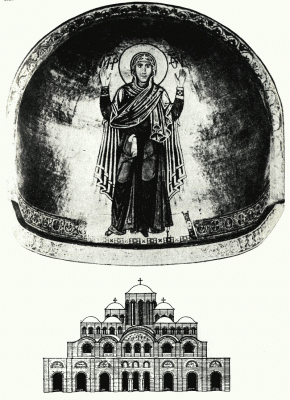
Virgin Orans. Mosaic in the apse of the Cathedral of St Sophia in Kiev. 11th century. Cathedral of St Sophia in Kiev. 11th century. Reconstruction
The genre of the chronicle is a very complex one: the chronicle is one of the “unifying genres” that subordinate the genres of their component parts—the historical tale, the vitae, the homily, the eulogy and so on.53 Nevertheless the chronicle is an integral work, which can be studied both as a work of a single genre and as a literary work.54
In The Tale of Bygone Years, as in any other chronicle, one can distinguish two types of narrative—the actual annual records and the chronicle stories. The annual records contain reports of events, while the chronicle stories offer descriptions of them. In the chronicle story the author strives to depict the event, to provide this or that concrete detail, to reproduce the dialogue of the personages, in brief, to help the reader to experience what is taking place, to arouse his emotions.
Thus, the story of the youth who flees from Kiev when it is besieged by the Pechenegs in order to deliver a request from Princess Olga to her commander Pretich, not only mentions the actual fact of the message being delivered, but also recounts how the boy runs through the Pecheneg camp with a bridle in his hand asking about his horse which has disappeared (and does not omit the important detail that the boy could speak the language of the Pechenegs), how he reaches the banks of the Dnieper, pulls off his clothes and dives into the water, and how Pretich’s men sail out to meet him in a boat; the dialogue between Pretich and the Pecheneg prince is also reported. This is a story, not a brief annual entry like, for example, “Svyatoslav conquered the Vyatichi and lay them under tribute”; “Vladimir founded the [cathedral of] Saint Sophia in Novgorod”, or “Vyacheslav, son of Yaroslav, died in Smolensk, and Igor was brought from Vladimir and enthroned in Smolensk”, etc.
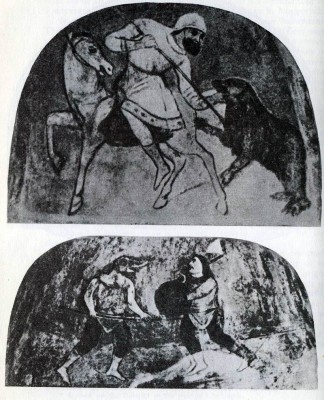
Bear Hunting. Fresco in the north section of the Cathedral of St Sophia in Kiev. 11th century. Two Mummers Fighting. Fresco in the north section of the Cathedral of St Sophia in Kiev. 11th century
At the same time the chronicle stories themselves can also be divided into two types, largely determined by their origin. Some describe events that occurred in the chronicler’s lifetime, others events that happened long before the chronicle was compiled. The latter are oral epic legends that were inserted in the chronicle later.
These epic legends are as a rule very entertaining: the events which they describe are exciting or impressive and the heroes are very strong, wise or cunning. They almost invariably contain an element of surprise.
The story of the young tanner (under the entry for 992) is based on the element of surprise. A Pecheneg prince who is fighting against Russia asks Vladimir to choose a warrior from his men who will try his strength against a huge Pecheneg. No one accepts the challenge. Vladimir is despondent, but then an old man comes to him and offers to send for his youngest son, who, the old man says, has been so strong since childhood that no one can get the better of him. One day, the father recalls, the son got angry with him and tore with his bare hands the piece of leather they were working (the old man is also a tanner). The youth is brought to Vladimir and demonstrates his strength to the prince by catching hold of a bull that is driven past him and pulling out a handful of its flesh. But the youth is short, and the giant Pecheneg who is “fearsome and great of stature” laughs at his opponent when he comes out to do combat with him. Here (as in the story of Olga’s revenge) a surprise awaits the evil character; the reader already knows about the youth’s strength and rejoices when the tanner strangles the huge Pecheneg with his bare hands.[2]
In another story it is not strength, but cunning that wins the day. Under the entry for 997 we read how the Pechenegs besieged the town of Belgorod (south of Kiev) and were sure that the inhabitants would surrender very soon, for there was “great hunger” in the town. And indeed the townsmen decided at a meeting of the veche to open the gates to the enemy. “They will kill some, but others will be spared,” the people said. Otherwise everyone would starve to death. But a certain old man suggested a different solution. On his advice they dug two wells, in which they put tubs of tsezh (the mixture from which they made jelly) and syta (honey diluted with water). Then they invited the Pecheneg envoys into the town and said to them:
“Why destroy yourselves? Surely you don’t think you can overcome us? What harm can you do us, even if you stay for ten years? We can get food out of the ground.” The envoys marvelled at the“magic wells” and persuaded their princes to lift the siege.
The Epic Style in the Chronicle. These chronicle stories are united by a special, epic style of depicting reality. This concept reflects, first and foremost, the attitude of the narrator towards the object he is depicting, his own standpoint, and not only the purely linguistic features of the exposition.55
These stories are characterised by an exciting plot, anonymous heroes (a young tanner, an old man from Belgorod, a Kievan who informs the commander Pretich of Olga’s decision—in the story about the siege of Kiev under the entry for 968), and short but lively dialogues; against the overall laconic description one or two details important for the development of the plot are singled out (the bridle in the youth’s hand, the detailed account of how the “magic wells” were dug in the story about the siege of Belgorod).
At the centre of each of these stories is a single event, a single episode, and it is this episode that characterises the hero, picks out his salient feature. In the story about the campaign against Constantinople Oleg is, first and foremost, the wise and brave warrior. The hero of the story about the siege of Belgorod is an unknown old man, but his wisdom, which at the last moment saves the besieged town, is the characteristic feature which wins him immortality in the popular memory.56 Epic stories are found primarily in The Tale of Bygone Years which is linked with the folk epic more closely than all the other chronicles. In later chronicle- writing they occur far less frequently.
The other group of stories is compiled by the chronicler himself or his contemporaries. It has a different style of narrative, in which we do not find a rounded plot or generalised epic characters. These stories may be more psychological, realistic and literary, since the chronicler is striving not simply to make the event known, but to relate it in such a manner as to produce a certain impression on the reader, to make him react in a certain way to the characters in the story. Among the stories of this kind in The Tale of Bygone Years the blinding of Vasilko of Terebovl stands out in particular (under the entry for 1097).
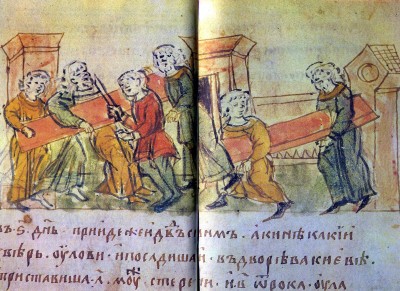
The Tale of Bygone Years. The Blinding of Vasilko of Terebovl. Illumination from The Radziwill Chronicle. 15th century. Academy of Sciences Library, Leningrad
In order to show exactly how the chronicler achieves the required literary and emotional effect on the reader, let us examine two episodes from the story.
Prince Svyatopolk of Kiev is persuaded by Prince David of Volhynia to invite Vasilko in order to imprison and blind him. Unaware of what awaits him, Vasilko arrives at the prince’s court. David and Svyatopolk take their guest inside. Svyatopolk persuades Vasilko to stay for a while. David, who is present during this conversation seems to be struck dumb. It was he who thought up the evil plot and now it is he who fears it. When Svyatopolk goes out, Vasilko starts talking to David, but David has lost his speech and hearing—he seems not to hear what is said to him and cannot reply. This is a very rare example in Old Russian writing of the early period, when the author seeks to convey a character’s inner state by such untraditional means. Then David too goes out, and the princes’ servants rush in. The chronicler describes the ensuing struggle in detail: in order to overcome Vasilko, who is strong and resists desperately, they knock him down and place a board taken from the stove on top of him. The men then sit on the board so heavily that Vasilko’s chest “cracks”. The blinding is described in similar detail. It is entrusted to the shepherd thus suggesting to the reader the comparison of Vasilko with a helpless lamb led to the slaughter.
All these details help the reader to picture the terrible scene and to persuade him that Vladimir Monomachos was right in taking up arms against Svyatopolk and David.
Specialists often quote another, equally expressive scene in the same story. The wounded and blinded Vasilko is being carried along in a cart. He is senseless. The men accompanying him (evidently David’s “lads”) take off his blood-stained shirt and give it to be washed to the wife of the priest in the village where they have stopped to dine. The priest’s wife washes the shirt, then comes up to Vasilko and begins to mourn him, thinking that he is dead. Hearing her laments, Vasilko asks, “Where am I?” “In Zwizhden town,” is the reply. Then he asks for water, and they give it to him, and he comes to, feels his shirt and says, “Why did they take it off me? It were better I had received death in that blood-stained shirt and gone before my Maker.”
This episode is narrated so carefully, with such concrete details, that it revives the memory of the prince’s terrible fate and arouses pity for him. The desire expressed by him to go before his Maker “in that blood-stained shirt” seems to serve as a reminder of inevitable retribution, to justify the “earthly” actions of the princes who waged war on David to restore Vasilko’s rights to the appanage that had been taken from him.
Thus, together with the chronicle narrative we find the emergence of a special genre, subject to the chronicle, the genre of the tale about princely crimes.57 The socio-political importance of these stories was so great that the authors obviously tried hard to perfect their literary form in order to make the narrative as moving as possible and justify the attitude of the side that denounces the crime in such stories.
The Monumental Historical Style in the Chronicle. Whereas the chronicle stories that derived from folk legends had a special epic style, the prevailing and all-embracing style in chronicle- writing of the eleventh and twelfth centuries, and in the literature of this period in general, was the monumental historical style.
This style reflects the striving of Old Russian scribes to assess everything from the viewpoint of the purpose and aim of human life. Therefore the writers in the eleventh to thirteenth centuries seek to depict only the major, most important things. The monumental historical style is characterised, first and foremost, by the striving to view the object portrayed at a considerable distance: spatially, temporally and hierarchically. It is a style within which all that is most significant and beautiful appears monumental and majestic, perceived from a great height, as it were.
The chroniclers (as well as the writers of vitae, eulogies and homilies) seem to be viewing the world from a great distance. This is a period of panoramic vision, of endeavours to combine in a single narrative different geographical points a long way from one another. The action in the chronicles suddenly switches from one place to another right on the other side of the Russian land. An account of events in Novgorod is followed by one about events in Vladimir or Kiev, then references to happenings in Smolensk or Galich, etc. This feature of the chronicle narrative is not only explained by the fact that the chronicle usually combines different sources written in different parts of the Russian land. It is also in keeping with the spirit of the narrative of that period. It is characteristic not only of the chronicle, but also of Vladimir Monomachos’ Instruction, the Patericon of the Kiev Crypt Monastery, the Life of SS Boris and Gleb, and the sermons or homilies.
At the same time the monumentalism of the eleventh to thirteenth centuries has one specific feature that distinguishes it from our modern view of the monumental as something inert, heavy and static. The monumentalism in Old Russian literature was linked with precisely the opposite qualities, in particular, with rapid movement over large geographical distances. The heroes are constantly on the move, travelling with their bodyguards from one town to another, from one principality to the next.
The historical aspect of the monumental style is expressed in the special predilection for historical themes. Old Russian writers sought to write not about imaginary things, but about historical facts, and even when they described something fantastic (miracles, for example), they themselves for the most part believed in it and tried to impress upon the reader that this or that event really did take place. The literature of that period did not have (or to be more precise, thought it did not have) any imaginary personages or imaginary events.
In addition scribes sought to link historical events and characters with other equally historical events or characters, to remind the reader of a prince’s ancestors, his “fathers” and “forefathers”, to compare a personage or an event with similar personages or events that they knew from the Byzantine chronicles or the Bible, to look for and find analogies for everything that took place in this vast world which was all governed by the same laws.
Literary Convention in the Chronicle. At the same time the literature of this period was distinguished by a ceremonial quality. This is seen quite clearly in the phenomenon which Dmitry Likhachev calls literary convention.
Literary convention, as it were, defines the tasks of literature, its themes, the principles of constructing the plot and, finally, the representational means themselves, singling out a range of the most desirable expressions, similes and metaphors.
The concept of literary convention is based on the idea of a stable, orderly world in which there is a special code of behaviour for each person. Literature should sanction and portray this static, normative world. This means that its main subject should be the portrayal of normative situations. If a chronicle is being written, attention should be focused on descriptions of the prince’s accession to the throne, battles, diplomatic acts, and the death and burial of the prince. In the latter case there is a kind of summing up of his life in generalised necrological form. Likewise in the lives of the saints there must be an account of their childhood, their path to sainthood, their traditional virtues (these, in particular, were almost compulsory for every saint), the miracles performed by them during their lifetime and after their death, etc.
Each of the above-mentioned situations, in which the hero of the chronicle or vita appears most clearly in his official capacity of prince or saint, must be portrayed in traditional expressions: the saint’s parents must be described as pious, the child who later becomes a saint must be said to shun games with other children, and battles are described in traditional phrases of the type: “and a fierce battle ensued”, “some were slain, others taken prisoner”, “they fought hard, grappling with one another, and the blood flowed in rivulets”, etc.
The chronicle narrative is full of convention, especially the passages that are written in the monumental historical style. Here the chronicler selects for his narrative only the most important events and deeds of national significance. Of course, if we demand of a style that it should strictly observe certain linguistic features (i.e., stylistic devices proper), we see that by no means every line in the chronicle illustrates the monumental historical style.
Firstly, because the varied phenomena of real life, and the chronicle had to correspond to real life, would not fit into a prearranged scheme of conventional situations, and therefore we find the most vivid manifestation of this style in the description of these situations: in the portrayal of the prince’s accession to the throne or his departure on a campaign, the descriptions of battles, obituaries, etc.
Secondly, because alongside the entries compiled by the chronicler in monumental historical style, we also find annual records, popular legends for which a different style is characteristic, namely, the epic style examined above, and stories of everyday life.
The monumental historical style is used, for example, for describing the events of the time of Yaroslav the Wise and his son Vsevolod. Suffice it to mention the description of the Battle on the Alta which brought Yaroslav victory over Svyatopolk the Accursed, the murderer of Boris and Gleb (under the year 1019 in The Tale of Bygone Years). Svyatopolk comes to the field of battle “with a vast host”. Yaroslav also assembles a large hand of warriors and marches out to engage him on the River Alta. Before the battle Yaroslav prays to God and his murdered brothers, asking for their help in the battle against this “murderer and arrogant man”. Then the two armies advance against each other “and the two great hosts did cover the Alta field”. At dawn “a fierce battle ensued the like of which there had ne’er before been in Russia, and they fought hard, grappling with one another, and came together three times, so that the blood flowed in rivulets”. Towards evening Yaroslav emerged victorious and Svyatopolk was put to flight. Yaroslav mounted the throne of Kiev, and “he and his men did wipe the sweat off their brows after their victory and great military feat”.
Everything in this story is intended to stress the historical importance of the battle: the reference to the large numbers of warriors, the details about the fierceness of the battle, and the impressive ending with Yaroslav victoriously mounting the Kievan throne which he won in battle for a “just cause”. But it is not so much an eyewitness account of a concrete battle, as a skilful interweaving of traditional subject matter and stock phrases in which other battles in The Tale of Bygone Years and later chronicles were described. The expression secha zla (“fierce battle”) is traditional, as is the ending which tells us who won and who fled. The reference to the large number of warriors and the phrases depicting the fury of the battle are also common in the chronicles.
The details about the princes in their obituaries are written with special care in The Tale of Bygone Years. For example, in the words of the chronicler (see the year 1093), Prince Vsevolod was “from childhood god-loving, and just, cared for the poor and needy, revered bishops and priests but above all loved monks and gave them all they needed”. This type of chronicle obituary was to be used many a time by the chroniclers of the twelfth and following centuries.60
The use of the formulas prescribed by literary convention gave the chronicle text a special flavour: not the effect of surprise, but, quite the reverse, the expectation of encountering something familiar, well known, expressed in a form polished and hallowed by tradition. The same device is well known in folklore as well—let us recall the traditional subjects of the bylina (heroic poem), the three-fold repetition of situations, the set epithets and similar devices of literary convention. Thus, the monumental historical style and its literary conventions do not signify a restriction of literary possibilities, but, quite the reverse, show a profound understanding of the role of the poetic word. At the same time, of course, this style did limit the freedom of the story-telling since it strove to standardise, to express different situations in set linguistic formulas and subject motifs.
This combination of the monumental historical and epic styles in The Tale of Bygone Years created its unique literary quality, and its stylistic influence was clearly felt for several centuries. Chroniclers began to use or adapt literary formulas first employed by the compilers of the Tale, to imitate the descriptions in it, and sometimes even to quote it, inserting passages from the Tale into their own text.61 The Tale has preserved its aesthetic charm right up to the present day, bearing eloquent witness to the literary skill of the Old Russian chroniclers.
[1] A town on the Dnieper to the west of Chernigov.
[2] The popular character of the story is evident in the fact that the tanner’s professionally strong hands, which have to tan leather, help him to conquer the giant Pecheneg.
 History of Russian Literature
History of Russian Literature

